Advertisements
Online Mock Tests
Chapters
2: Structure of Atom
3: Classification of Elements and Periodicity in Properties
4: Chemical Bonding and Molecular Structure
5: States of Matter
6: Thermodynamics
7: Equilibrium
8: Redox Reactions
9: Hydrogen
10: The s-block Elements
11: The p-block Elements
▶ 12: Organic Chemistry Some Basic Principles and Techniques
13: Hydrocarbons
14: Environmental Chemistry
![NCERT Exemplar solutions for Chemistry [English] Class 11 chapter 12 - Organic Chemistry Some Basic Principles and Techniques NCERT Exemplar solutions for Chemistry [English] Class 11 chapter 12 - Organic Chemistry Some Basic Principles and Techniques - Shaalaa.com](/images/chemistry-english-class-11_6:5f2b1b2038084cf381bfa42c826a928c.jpg)
Advertisements
Solutions for Chapter 12: Organic Chemistry Some Basic Principles and Techniques
Below listed, you can find solutions for Chapter 12 of CBSE NCERT Exemplar for Chemistry [English] Class 11.
NCERT Exemplar solutions for Chemistry [English] Class 11 12 Organic Chemistry Some Basic Principles and Techniques Multiple Choice Questions (Type - I) [Pages 144 - 156]
Which of the following is the correct IUPAC name?
3-Ethyl-4, 4-dimethylheptane
4, 4-Dimethyl-3-ethylheptane
5-Ethyl-4, 4-dimethylheptane
4, 4-Bis(methyl)-3-ethylheptane
The IUPAC name for \[\begin{array}{cc}
\phantom{.}\ce{O}\phantom{................}\ce{O}\phantom{.}\\
\phantom{}||\phantom{.................}||\phantom{}\\
\ce{CH - C - CH2 - CH2 - C - OH}
\end{array}\] is ______.
1-hydroxypentane-1, 4-dion
1, 4-dioxopentanol
1-carboxybutan-3-one
4-oxopentanoic acid
The IUPAC name for

1-Chloro-2-nitro-4-methylbenzene
1-Chloro-4-methyl-2-nitrobenzene
2-Chloro-1-nitro-5-methylbenzene
m-Nitro-p-chlorotoluene
Electronegativity of carbon atoms depends upon their state of hybridisation. In which of the following compounds, the carbon marked with asterisk is most electronegative?
CH3 – CH2 – *CH2 –CH3
CH3 – *CH = CH – CH3
CH3 – CH2 – C ≡ *CH
CH3 – CH2 – CH = *CH2
In which of the following, functional group isomerism is not possible?
Alcohols
Aldehydes
Alkyl halides
Cyanides
The fragrance of flowers is due to the presence of some steam volatile organic compounds called essential oils. These are generally insoluble in water at room temperature but are miscible with water vapour in vapour phase. A suitable method for the extraction of these oils from the flowers is ______.
Distillation
Crystallisation
Distillation under reduced pressure
Steam distillation
During hearing of a court case, the judge suspected that some changes in the documents had been carried out. He asked the forensic department to check the ink used at two different places. According to you which technique can give the best results?
Column chromatography
Solvent extraction
Distillation
Thin layer chromatography
The principle involved in paper chromatography is ______.
Adsorption
Partition
Solubility
Volatility
What is the correct order of decreasing stability of the following cations.
| I. | \[\ce{CH3 - \overset{⊕}{C}H - CH3}\] |
| II. | \[\ce{CH3 - \overset{⊕}{C}H - OCH3}\] |
| III. | \[\ce{CH3 - \overset{⊕}{C}H - CH2 - OCH3}\] |
II > I > III
II > III > I
III > I > II
I > II > III
Correct IUPAC name for \[\begin{array}{cc}
\ce{H3C - CH - CH - CH3}\\
\phantom{}|\phantom{......}|\phantom{..}\\
\phantom{..}\ce{C2H5}\phantom{..}\ce{C2H5}\phantom{}
\end{array}\] is ______.
2-ethyl-3-methylpentane
3, 4-dimethylhexane
2-sec-butylbutane
2, 3-dimethylbutane
In which of the following compounds the carbon marked with asterisk is expected to have greatest positive charge?
*CH3 – CH2 – Cl
*CH3 – CH2 – Mg+ Cl–
*CH3 – CH2 – Br
*CH3 – CH2 – CH3
Ionic species are stabilised by the dispersal of charge. Which of the following carboxylate ion is the most stable?
\[\begin{array}{cc}
\phantom{...}\ce{O}\\
\phantom{...}||\\
\ce{CH3 - C - O}
\end{array}\]\[\begin{array}{cc}
\phantom{........}\ce{O}\\
\phantom{........}||\\
\ce{Cl - CH2 - C - O}
\end{array}\]\[\begin{array}{cc}
\phantom{........}\ce{O}\\
\phantom{........}||\\
\phantom{.}\ce{F - CH2 - C - O}
\end{array}\]\[\begin{array}{cc}
\phantom{}\ce{F}\phantom{......}\ce{O}\\
\phantom{}\backslash\phantom{......}||\\
\phantom{......}\ce{CH - C - O}\\
\phantom{}/\phantom{.......}\\
\ce{F}\phantom{.........}
\end{array}\]
Electrophilic addition reactions proceed in two steps. The first step involves the addition of an electrophile. Name the type of intermediate formed in the first step of the following addition reaction.
\[\ce{H3C - HC = CH2 + H+ ->?}\]
2° Carbanion
1° Carbocation
2° Carbocation
1° Carbanion
Covalent bond can undergo fission in two different ways. The correct representation involving a heterolytic fission of CH3 – Br is:
The addition of HCl to an alkene proceeds in two steps. The first step is the attack of H+ ion to  portion which can be shown as:
portion which can be shown as:



All of these are possible
Which of the following compounds contain all the carbon atoms in the same hybridisation state?
(i) H – C ≡ C – C ≡ C – H
(ii) CH3 – C ≡ C – CH3
(iii) CH2 = C = CH2
(iv) CH2 = CH – CH = CH2
In which of the following representations given below spatial arrangement of group/ atom different from that given in structure ‘A’?
 |
| (A) |
| (i) |  |
| (ii) |  |
| (iii) |  |
| (iv) |  |
Electrophiles are electron seeking species. Which of the following groups contain only electrophiles?
(i) \[\ce{BF3, NH3, H2O}\]
(ii) \[\ce{AlCl3, SO3, NO^{+}2}\]
(iii) \[\ce{NO^{+}2, CH^{+}3, CH3 - \overset{+}{C} = O}\]
(iv) \[\ce{C2H^{-}5, \overset{\bullet}{C2}H5, C2H^{+}5}\]
Which of the following pairs are position isomers?
| I. | \[\begin{array}{cc} \phantom{.......................}\ce{O}\\ \phantom{.......................}||\\ \ce{CH3 - CH2 - CH2 - CH2 - C - H} \end{array}\] |
| II. | \[\begin{array}{cc} \phantom{.................}\ce{O}\\ \phantom{.................}||\\ \ce{CH3 - CH2 - CH2 - C - H} \end{array}\] |
| III. | \[\begin{array}{cc} \ce{CH3 - CH2 - C - CH2 - CH3}\\ \phantom{}||\\ \phantom{}\ce{O} \end{array}\] |
| IV. | \[\begin{array}{cc} \ce{CH3 - CH - CH2 - C - H}\\ \phantom{...}|\phantom{............}||\phantom{}\\ \phantom{...}\ce{CH3}\phantom{.........}\ce{O}\phantom{} \end{array}\] |
(i) I and II
(ii) II and III
(iii) II and IV
(iv) III and IV
Which of the following pairs are not functional group isomers?
| I. | \[\begin{array}{cc} \phantom{.......................}\ce{O}\\ \phantom{.......................}||\\ \ce{CH3 - CH2 - CH2 - CH2 - C - H} \end{array}\] |
| II. | \[\begin{array}{cc} \phantom{.................}\ce{O}\\ \phantom{.................}||\\ \ce{CH3 - CH2 - CH2 - C - H} \end{array}\] |
| III. | \[\begin{array}{cc} \ce{CH3 - CH2 - C - CH2 - CH3}\\ \phantom{}||\\ \phantom{}\ce{O} \end{array}\] |
| IV. | \[\begin{array}{cc} \ce{CH3 - CH - CH2 - C - H}\\ \phantom{...}|\phantom{............}||\phantom{}\\ \phantom{...}\ce{CH3}\phantom{.........}\ce{O}\phantom{} \end{array}\] |
(i) II and III
(ii) II and IV
(iii) I and IV
(iv) I and II
Nucleophile is a species that should have:
(i) A pair of electrons to donate
(ii) Positive charge
(iii) Negative charge
(iv) Electron-deficient species
Hyperconjugation involves delocalisation of:
(i) Electrons of carbon-hydrogen σ bond of an alkyl group directly attached to an atom of unsaturated system.
(ii) Electrons of carbon-hydrogen σ bond of alkyl group directly attached to the positively charged carbon atom.
(iii) π-electrons of carbon-carbon bond.
(iv) Lone pair of electrons.
Consider structures I to VII and answer the question:
| I. | CH3 – CH2 – CH2 – CH2 – OH |
| II. | \[\begin{array}{cc} \ce{CH3 - CH2 - CH - CH3}\\ \phantom{.....}|\\ \phantom{.......}\ce{OH} \end{array}\] |
| III. | \[\begin{array}{cc} \phantom{...}\ce{CH3}\\ \phantom{}|\\ \ce{CH3 - C - CH3}\\ \phantom{}|\\ \phantom{..}\ce{OH} \end{array}\] |
| IV. | \[\begin{array}{cc} \ce{CH3 - CH - CH2 - OH}\\ |\phantom{........}\\ \ce{CH3}\phantom{......} \end{array}\] |
| V. | CH3 – CH2 – O – CH2 – CH3 |
| VI. | CH3 – O – CH2 – CH2 – CH3 |
| VII. | \[\begin{array}{cc} \ce{CH3 - O - CH - CH3}\\ \phantom{...}|\\ \phantom{......}\ce{CH3} \end{array}\] |
Which of the above compounds form pairs of metamers?
Consider structures I to VII and answer the question:
| I. | CH3 – CH2 – CH2 – CH2 – OH |
| II. | \[\begin{array}{cc} \ce{CH3 - CH2 - CH - CH3}\\ \phantom{.....}|\\ \phantom{.......}\ce{OH} \end{array}\] |
| III. | \[\begin{array}{cc} \phantom{...}\ce{CH3}\\ \phantom{}|\\ \ce{CH3 - C - CH3}\\ \phantom{}|\\ \phantom{..}\ce{OH} \end{array}\] |
| IV. | \[\begin{array}{cc} \ce{CH3 - CH - CH2 - OH}\\ |\phantom{........}\\ \ce{CH3}\phantom{......} \end{array}\] |
| V. | CH3 – CH2 – O – CH2 – CH3 |
| VI. | CH3 – O – CH2 – CH2 – CH3 |
| VII. | \[\begin{array}{cc} \ce{CH3 - O - CH - CH3}\\ \phantom{...}|\\ \phantom{......}\ce{CH3} \end{array}\] |
Identify the pairs of compounds which are functional group isomers.
Consider structures I to VII and answer the question:
| I. | CH3 – CH2 – CH2 – CH2 – OH |
| II. | \[\begin{array}{cc} \ce{CH3 - CH2 - CH - CH3}\\ \phantom{.....}|\\ \phantom{.......}\ce{OH} \end{array}\] |
| III. | \[\begin{array}{cc} \phantom{...}\ce{CH3}\\ \phantom{}|\\ \ce{CH3 - C - CH3}\\ \phantom{}|\\ \phantom{..}\ce{OH} \end{array}\] |
| IV. | \[\begin{array}{cc} \ce{CH3 - CH - CH2 - OH}\\ |\phantom{........}\\ \ce{CH3}\phantom{......} \end{array}\] |
| V. | CH3 – CH2 – O – CH2 – CH3 |
| VI. | CH3 – O – CH2 – CH2 – CH3 |
| VII. | \[\begin{array}{cc} \ce{CH3 - O - CH - CH3}\\ \phantom{...}|\\ \phantom{......}\ce{CH3} \end{array}\] |
Identify the pairs of compounds that represents position isomerism.
Consider structures I to VII and answer the question:
| I. | CH3 – CH2 – CH2 – CH2 – OH |
| II. | \[\begin{array}{cc} \ce{CH3 - CH2 - CH - CH3}\\ \phantom{.....}|\\ \phantom{.......}\ce{OH} \end{array}\] |
| III. | \[\begin{array}{cc} \phantom{...}\ce{CH3}\\ \phantom{}|\\ \ce{CH3 - C - CH3}\\ \phantom{}|\\ \phantom{..}\ce{OH} \end{array}\] |
| IV. | \[\begin{array}{cc} \ce{CH3 - CH - CH2 - OH}\\ |\phantom{........}\\ \ce{CH3}\phantom{......} \end{array}\] |
| V. | CH3 – CH2 – O – CH2 – CH3 |
| VI. | CH3 – O – CH2 – CH2 – CH3 |
| VII. | \[\begin{array}{cc} \ce{CH3 - O - CH - CH3}\\ \phantom{...}|\\ \phantom{......}\ce{CH3} \end{array}\] |
Identify the pairs of compounds that represents chain isomerism.
For testing halogens in an organic compound with AgNO3 solution, sodium extract (Lassaigne’s test) is acidified with dilute HNO3. What will happen if a student acidifies the extract with dilute H2SO4 in place of dilute HNO3?
What is the hybridisation of each carbon in H2C = C = CH2.
Explain, how is the electronegativity of carbon atoms related to their state of hybridisation in an organic compound?
Show the polarisation of carbon-magnesium bond in the following structure.
CH3 – CH2 – CH2 – CH2 – Mg – X
Compounds with same molecular formula but differing in their structures are said to be structural isomers. What type of structural isomerism is shown by
CH3 – S – CH2 – CH2 – CH3
And
\[\begin{array}{cc}
\phantom{.....................}\ce{CH3}\\
\phantom{................}/\\
\phantom{}\ce{CH3 - S - CH}\\
\phantom{...............}\backslash\\
\phantom{....................}\ce{CH3}
\end{array}\]
Which of the following selected chains is correct to name the given compound according to IUPAC system.
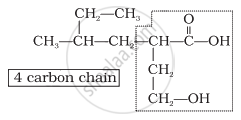
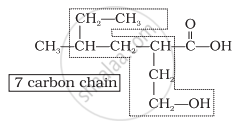
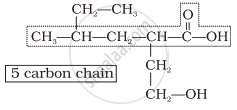
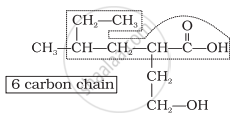
In DNA and RNA, nitrogen atom is present in the ring system. Can Kjeldahl method be used for the estimation of nitrogen present in these? Give reasons.
If a liquid compound decomposes at its boiling point, which method (s) can you choose for its purification. It is known that the compound is stable at low pressure, steam volatile and insoluble in water.
Draw the possible resonance structures for \[\ce{CH3 - \overset{\bullet\bullet}{\underset{\bullet\bullet}{O}} - \overset{+}{C}H2}\] and predict which of the structures is more stable. Give reason for your answer.
Which of the following ions is more stable? Use resonance to explain your answer.
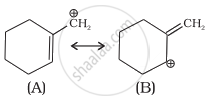
The structure of triphenylmethyl cation is given below. This is very stable and some of its salts can be stored for months. Explain the cause of high stability of this cation.

Write structures of various carbocations that can be obtained from 2-methylbutane. Arrange these carbocations in order of increasing stability.
Three students, Manish, Ramesh and Rajni were determining the extra elements present in an organic compound given by their teacher. They prepared the Lassaigne’s extract (L.E.) independently by the fusion of the compound with sodium metal. Then they added solid FeSO4 and dilute sulphuric acid to a part of Lassaigne’s extract. Manish and Rajni obtained prussian blue colour but Ramesh got red colour. Ramesh repeated the test with the same Lassaigne’s extract, but again got red colour only. They were surprised and went to their teacher and told him about their observation. Teacher asked them to think over the reason for this. Can you help them by giving the reason for this observation. Also, write the chemical equations to explain the formation of compounds of different colours.
Name the compounds whose line formulae are given below:
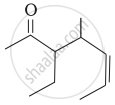
Name the compounds whose line formulae are given below:

Write structural formulae for compounds named as-
1-Bromoheptane
Write structural formulae for compounds named as-
5-Bromoheptanoic acid
Draw the resonance structure of the following compounds;

Draw the resonance structure of the following compounds;
CH2 = CH – CH = CH2
Draw the resonance structure of the following compounds;
\[\begin{array}{cc}
\ce{CH2 = CH - C = O}\\
\phantom{.........}|\\
\phantom{.........}\ce{H}
\end{array}\]
Identify the most stable species in the following set of ions giving reason:
\[\ce{\overset{+}{C}H3, \overset{+}{C}H2Br, \overset{+}{C}HBr2, \overset{+}{C}Br3}\]
Identify the most stable species in the following set of ions giving reason:
\[\ce{\overset{Θ}{C}H3, \overset{Θ}{C}H2Cl, \overset{Θ}{C}HCl2, \overset{Θ}{C}Cl3}\]
Give three points of differences between inductive effect and resonance effect.
Which of the following compounds will not exist as resonance hybrid. Give reason for your answer:
CH3OH
R – CONH2
CH3CH = CHCH2NH2
Why does SO3 act as an electrophile?
Resonance structures of propenal are given below. Which of these resonating structures is more stable? Give reason for your answer.
\[\ce{\underset{I}{CH2 = CH - CH = O} <-> \underset{II}{\overset{⊕}{C}H2 - CH = CH - \overset{Θ}{O}}}\]
By mistake, an alcohol (boiling point 97°C) was mixed with a hydrocarbon (boiling point 68°C). Suggest a suitable method to separate the two compounds. Explain the reason for your choice.
Which of the two structures (A) and (B) given below is more stabilised by resonance? Explain.
\[\ce{\underset{(A)}{CH3COOH}}\] and \[\ce{\underset{(B)}{CH3CO\overset{Θ}{O}}}\]
Match the type of mixture of compounds in Column I with the technique of separation/purification given in Column II.
| Column I | Column II |
| (i) Two solids which have different solubilities in a solvent and which do not undergo reaction when dissolved in it. | (a) Steam distillation |
| (ii) Liquid that decomposes at its boiling point | (b) Fractional distillation |
| (iii) Steam volatile liquid | (c) Simple distillation |
| (iv) Two liquids which have boiling points close to each other | (d) Distillation under reduced pressure |
| (v) Two liquids with large difference in boiling points. | (e) Crystallisation |
Match the terms mentioned in Column I with the terms in Column II.
| Column I | Column II |
| (i) Carbocation | (a) Cyclohexane and 1-hexene |
| (ii) Nucleophile of | (b) Conjugation of electrons of C – H σ bond with empty p-orbital present at adjacent positively charged carbon. |
| (iii) Hyperconjugation | (c) sp2 hybridised carbon with empty p-orbital |
| (iv) Isomers | (d) Ethyne |
| (v) sp hybridisation | (e) Species that can receive a pair of electrons |
| (vi) Electrophile | (f) Species that can supply a pair of electrons |
Match Column I with Column II.
| Column I | Column II |
| (i) Dumas method | (a) AgNO3 |
| (ii) Kjeldahl’s method | (b) Silica gel |
| (iii) Carius method | (c) Nitrogen gas |
| (iv) Chromatography | (d) Free radicals |
| (v) Homolysis | (e) Ammonium sulphate |
Match the intermediates given in Column I with their probable structure in Column II.
| Column I | Column II |
| (i) Free radical | (a) Trigonal planar |
| (ii) Carbocation | (b) Pyramidal |
| (iii) Carbanion | (c) Linear |
Match the ions given in Column I with their nature given in Column II.
| Column I | Column II |
| (i) \[\ce{CH3 - \overset{\bullet\bullet}{\underset{\bullet\bullet}{O}} - \overset{⊕}{C}H - CH3}\] | (a) Stable due to resonance |
| (ii) \[\ce{F3 - \overset{⊕}{C}}\] | (b) Destabilised due to inductive effect |
|
(iii) \[\begin{array}{cc} |
(c) Stabilised by hyperconjugation |
| (iv) \[\ce{CH3 - \overset{⊕}{C}H - CH3}\] | (d) A secondary carbocation |
Assertion (A): Simple distillation can help in separating a mixture of propan-1-ol (boiling point 97°C) and propanone (boiling point 56°C).
Reason (R): Liquids with a difference of more than 20°C in their boiling points can be separated by simple distillation.
Both A and R are correct and R is the correct explanation of A.
Both A and R are correct but R is not the correct explanation of A.
Both A and R are not correct.
A is not correct but R is correct.
Assertion (A): Energy of resonance hybrid is equal to the average of energies of all canonical forms.
Reason (R): Resonance hybrid cannot be presented by a single structure.
Both A and R are correct and R is the correct explanation of A.
Both A and R are correct but R is not the correct explanation of A.
Both A and R are not correct.
A is not correct but R is correct.
Assertion (A): Pent- 1- ene and pent- 2- ene are position isomers.
Reason (R): Position isomers differ in the position of functional group or a substituent.
Both A and R are correct and R is the correct explanation of A.
Both A and R are correct but R is not the correct explanation of A.
Both A and R are not correct.
A is not correct but R is correct.
Assertion (A): All the carbon atoms in H2C = C = CH2 are sp2 hybridised
Reason (R): In this molecule all the carbon atoms are attached to each other by double bonds.
Both A and R are correct and R is the correct explanation of A.
Both A and R are correct but R is not the correct explanation of A.
Both A and R are not correct.
A is not correct but R is correct.
Assertion (A): Sulphur present in an organic compound can be estimated quantitatively by Carius method.
Reason (R): Sulphur is separated easily from other atoms in the molecule and gets precipitated as light yellow solid.
Both A and R are correct and R is the correct explanation of A.
Both A and R are correct but R is not the correct explanation of A.
Both A and R are not correct.
A is not correct but R is correct.
Assertion (A): Components of a mixture of red and blue inks can be separated by distributing the components between stationary and mobile phases in paper chromatography.
Reason (R): The coloured components of inks migrate at different rates because paper selectively retains different components according to the difference in their partition between the two phases.
Both A and R are correct and R is the correct explanation of A.
Both A and R are correct but R is not the correct explanation of A.
Both A and R are not correct.
A is not correct but R is correct.
What is meant by hybridisation? Compound CH2 = C = CH2 contains sp or sp2 hybridised carbon atoms. Will it be a planar molecule?
Benzoic acid is a organic compound. Its crude sample can be purified by crystallisation from hot water. What characteristic differences in the properties of benzoic acid and the impurity make this process of purification suitable?
Two liquids (A) and (B) can be separated by the method of fractional distillation. The boiling point of liquid (A) is less than boiling point of liquid (B). Which of the liquids do you expect to come out first in the distillate? Explain.
You have a mixture of three liquids A, B and C. There is a large difference in the boiling points of A and rest of the two liquids i.e., B and C. Boiling point of liquids B and C are quite close. Liquid A boils at a higher temperature than B and C and boiling point of B is lower than C. How will you separate the components of the mixture. Draw a diagram showing set up of the apparatus for the process.
Draw a diagram of bubble plate type fractionating column. When do we require such type of a column for separating two liquids. Explain the principle involved in the separation of components of a mixture of liquids by using fractionating column. What industrial applications does this process have?
A liquid with high boiling point decomposes on simple distillation but it can be steam distilled for its purification. Explain how is it possible?
Solutions for 12: Organic Chemistry Some Basic Principles and Techniques
![NCERT Exemplar solutions for Chemistry [English] Class 11 chapter 12 - Organic Chemistry Some Basic Principles and Techniques NCERT Exemplar solutions for Chemistry [English] Class 11 chapter 12 - Organic Chemistry Some Basic Principles and Techniques - Shaalaa.com](/images/chemistry-english-class-11_6:5f2b1b2038084cf381bfa42c826a928c.jpg)
NCERT Exemplar solutions for Chemistry [English] Class 11 chapter 12 - Organic Chemistry Some Basic Principles and Techniques
Shaalaa.com has the CBSE Mathematics Chemistry [English] Class 11 CBSE solutions in a manner that help students grasp basic concepts better and faster. The detailed, step-by-step solutions will help you understand the concepts better and clarify any confusion. NCERT Exemplar solutions for Mathematics Chemistry [English] Class 11 CBSE 12 (Organic Chemistry Some Basic Principles and Techniques) include all questions with answers and detailed explanations. This will clear students' doubts about questions and improve their application skills while preparing for board exams.
Further, we at Shaalaa.com provide such solutions so students can prepare for written exams. NCERT Exemplar textbook solutions can be a core help for self-study and provide excellent self-help guidance for students.
Concepts covered in Chemistry [English] Class 11 chapter 12 Organic Chemistry Some Basic Principles and Techniques are Tetravalence of Carbon - Shapes of Organic Compounds, Complete, Condensed and Bond-line Structural Formulas, Three-dimensional Representation of Organic Molecules, Classification of Organic Compounds, The IUPAC System of Nomenclature, IUPAC Nomenclature of Alkanes, Nomenclature of Organic Compounds Having Functional Group(s), Nomenclature of Substituted Benzene Compounds, Fission of a Covalent Bond, Nucleophiles and Electrophiles, Electron Movement in Organic Reactions, Electron Displacement Effects in Covalent Bonds, Inductive Effect, Resonance Structure, Resonance Effect, Electromeric Effect (E Effect), Hyperconjugation, Types of Organic Reactions and Mechanisms, Introduction of Methods of Purification of Organic Compounds, Qualitative Analysis of Organic Compounds - Detection of Carbon and Hydrogen, Quantitative Analysis of Nitrogen, Quantitative Analysis of Halogens, Quantitative Analysis of Sulphur, Quantitative Analysis of Phosphorus, Quantitative Analysis of Oxygen, Simple Distillation Method, Chromatography Method, Isomerism, Qualitative Analysis of Organic Compounds - Detection of Other Elements, Quantitative Analysis of Carbon and Hydrogen, Crystallisation Method, Sublimation Method, Solvent Extraction (Using a Separating Funnel Method).
Using NCERT Exemplar Chemistry [English] Class 11 solutions Organic Chemistry Some Basic Principles and Techniques exercise by students is an easy way to prepare for the exams, as they involve solutions arranged chapter-wise and also page-wise. The questions involved in NCERT Exemplar Solutions are essential questions that can be asked in the final exam. Maximum CBSE Chemistry [English] Class 11 students prefer NCERT Exemplar Textbook Solutions to score more in exams.
Get the free view of Chapter 12, Organic Chemistry Some Basic Principles and Techniques Chemistry [English] Class 11 additional questions for Mathematics Chemistry [English] Class 11 CBSE, and you can use Shaalaa.com to keep it handy for your exam preparation.




